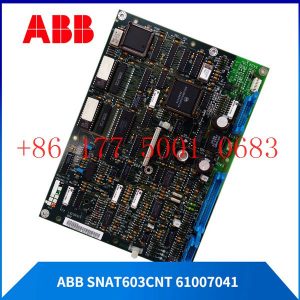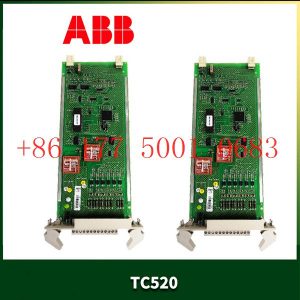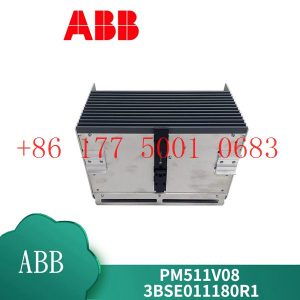Description
hardware flow control. It is an ideal choice in the field of industrial automation.
According to reports, ABB”s technical expertise and experience in many industries will be combined with Microsoft”s Azure intelligent cloud system and B2B
engineering capabilities to create greater value for customers. Combined with ABB”s more than 70 million connected devices installed globally and more than
70,000 running control systems, ABB and Microsoft will join forces to create one of the world”s largest IIoT industrial cloud platforms.
It is worth noting that IoT expert Guido Jouret (formerly general manager of Cisco’s IoT department) became the group’s chief digital officer on October 1, 2016.
This marks that ABB is accelerating digital transformation and comprehensively building a new “Internet of Things+” ecosystem. ABB also hopes to obtain higher
profits from this, and has proposed a financial target for 2015-2020 of pre-tax profit growth of 11%-16%.
FANUC
FANUC recently established the IoT platform Fanuc Intelligent Edge Link and Drive (FIELD), which uses NVIDIA artificial intelligence system. FIELD can realize the
connection of machine tools, robots, peripheral equipment and sensors in the automation system and provide advanced data analysis to improve the production quality,
efficiency, flexibility and equipment reliability in the production process – thereby improving the overall efficiency of the equipment ( OEE) and promote the improvement of production profits.
The system can also improve robot productivity through artificial intelligence and bring autonomous learning capabilities to automated factory robots around the
world. FANUC will use a series of GPUs and deep learning software designed and produced by NVIDIA to enable AI artificial intelligence to be used in clouds, data centers
and embedded devices.
When talking about the cooperation with FANUC, NVIDIA co-founder and CEO Jensen Huang said that the era of AI artificial intelligence has officially arrived.
Through the deep learning function of GPU, it will stimulate a
new wave of software learning and machine inference calculations. The most exciting of these is the ability of robots to understand their surroundings and
interact with humans. NVIDIA is very happy to work with FANUC, the global leader in automated factories and robots, to build intelligent machines to benefit the future of mankind.
It is reported that FIELD continues the success of the existing Fanuc ZDT (zero downtime function), which effectively combines Cisco cloud technology,
IoT data collection software and point-to-point security. After connecting the robot through the use of an industrial Ethernet switch, it is then connected to Cisco”s UCS server – the system runs
based on FANUC and Cisco”s ZDT data collection software. Automotive industry users can immediately realize reductions in downtime and cost savings after using the system.
FIELD provides users and application developers with advanced machine learning and artificial intelligence capabilities and brings manufacturing to
new heights of productivity and efficiency. Currently, FANUC has applied these new technologies to robotic bulk picking, production anomaly detection and fault
prediction. Because FIELD combines artificial intelligence and cutting-edge computer technology, distributed learning is possible. The operating data of robots and
equipment are processed in real time on the network,
which also enables more intelligent coordination of production between various equipment, making complex production coordination that was previously difficult to
achieve easily completed.
In fact, many years ago, FANUC began to cooperate with Cisco to carry out the “non-stop” zero downTIme plan. In the plan, FANUC and Cisco will join forces to
build an Internet of Things system that will allow FANUC to supervise
every robot in the factory, predict abnormal conditions of the robots, and send more technicians to repair the robots before problems occur. So far, the program has
tested 2,500 robots, including FANUC”s major customer GM General Motors. According to FANUC, the test program saved customers $38 million.
YASKAWA
After talking so much about the Internet of Things strategy of the industrial robot giant, let’s take a break here at Yaskawa and talk about the past.
Midea and KUKA have officially received their marriage certificates, but you must know that as early as August 2015, Midea announced its
robot strategy and established two joint venture subsidiaries with Japan”s Yaskawa Electric.
The two subsidiaries are respectively for industrial robots and service robots, including Guangdong Yaskawa Midea Industrial Robot Co.
, Ltd. (Midea”s equity accounted for 49%) and Guangdong Midea Yaskawa Service Robot Co., Ltd. (Midea”s equity accounted for 60%).
This shows that as early as 2015, Midea was actually “in love” with Yaskawa, but by 2016, she married Kuka.
Excitation system ABB module 3AFE61320946P0001 POS.A6091
Excitation system ABB module 3ADT316300R1510 SDCS-PIN-4B
Excitation system ABB module 3ABD10058721DX5221
Excitation system ABB module 37911-4-0338125
Excitation system ABB module 23BA20D
Excitation system ABB module 216VC62a HESG324442R13/E
Excitation system ABB module 216VC62A HESG324442R112/F
Excitation system ABB module 216VC62a
Excitation system ABB module 216VC62A
Excitation system ABB module 216NG63A HESG441635R1
Excitation system ABB module 216NG63
Excitation system ABB module 216NG62A HESG441634R1/K
Excitation system ABB module 216NG61A HESG441633R1
Excitation system ABB module 216GD61a
Excitation system ABB module 216EA62 1MRB150083R1/F
Excitation system ABB module 216EA61b
Excitation system ABB module 216DB61 HESG324063R100/J
Excitation system ABB module 216DB61
Excitation system ABB module 216AB61
Excitation system ABB module 216AB61
Excitation system ABB module 1VCF752000
Excitation system ABB module 1TGE120028R0010
Excitation system ABB module 1TGE120028R0010
Excitation system ABB module 1TGE120021R0110
Excitation system ABB module 1TGE120021R0110
Excitation system ABB module 1TGE120021R0010
Excitation system ABB module 1tge120011r1001
Excitation system ABB module 1TGE120011R1000
Excitation system ABB module 1TGE120010R1300
Excitation system ABB module 1TGE120010R
Excitation system ABB module 1TGE106170M4200
Excitation system ABB module 1TGB302003R0003
Excitation system ABB module 1SVR450081R0000
Excitation system ABB module 1SVR360663R1001
Excitation system ABB module 1SVR040000R1700
Excitation system ABB module 1SVR011718R2500
Excitation system ABB module 1SVR011718R2500
Excitation system ABB module 1SNA684252R0200
Excitation system ABB module 1SFB536068D1011
Excitation system ABB module 1SBP260022R1001
Excitation system ABB module 1SAR700012R0005
Excitation system ABB module 1SAP530100R0001
Excitation system ABB module 1SAP520100R0001
Excitation system ABB module 1SAP173200R0001
Excitation system ABB module 1SAP150000R0170 PM590-ETH
Excitation system ABB module 1SAJ520000R0101 UMC100
Excitation system ABB module 1MRS050644
Excitation system ABB module 1MRS050644
Excitation system ABB module 1MRS050496
Excitation system ABB module 1MRK002246-BD
Excitation system ABB module 129765-008
Excitation system ABB module 129740-102
Excitation system ABB module 129740-002
Excitation system ABB module 129740-002
Excitation system ABB module 128877-103
Excitation system ABB module 086444-005
Excitation system ABB module 086407-502
Excitation system ABB module 086370-001
Excitation system ABB module 086370-001
Excitation system ABB module 086349-002
Excitation system ABB module 086345-504
Excitation system ABB module 086339-501
Excitation system ABB module 086339-001
Excitation system ABB module 086329-004
Excitation system ABB module 086329-004
Excitation system ABB module 086329-003
Excitation system ABB module 086318-002
Excitation system ABB module 086318-002









Reviews
There are no reviews yet.